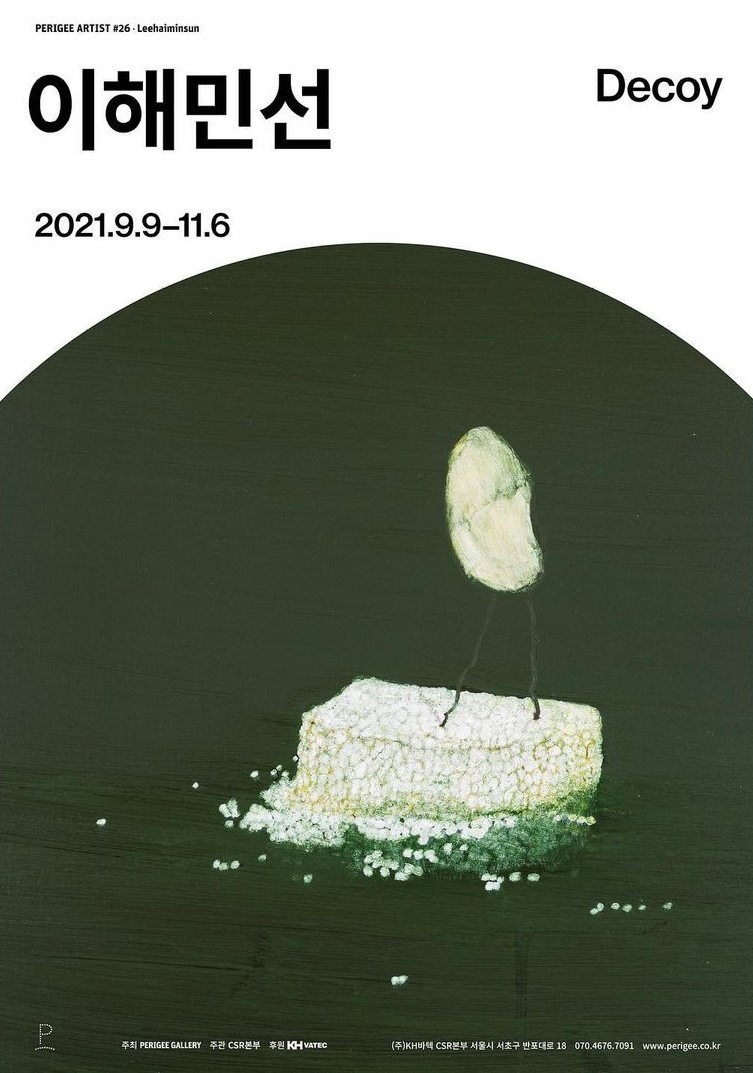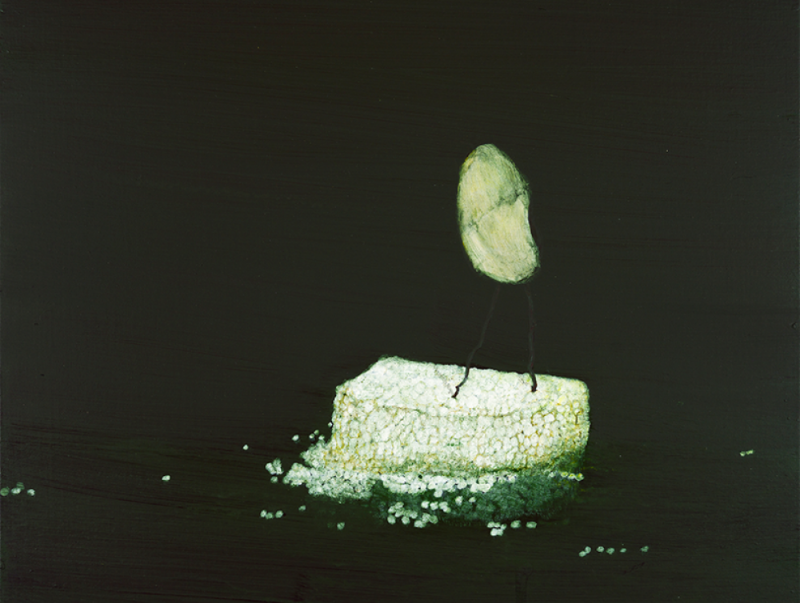
| Period| | 2021.09.09 - 2021.11.06 |
|---|---|
| Operating hours| | 10:30 - 18:00 |
| Space| | Perigee Gallery |
| Address| | 18, Banpo-daero, Seocho-gu, Seoul, Republic of Korea |
| Closed| | Sundays, public holidays, December 31, January 1 |
| Price| | Free |
| Phone| | 070-4676-7096 |
| Web site| | 홈페이지 바로가기 |
| Artist| |
|
정보수정요청



|
|
Exhibition Information

The Trace Eyes Stay Seung Oh Shin, Director of Perigee Gallery Objects in Leehaiminsun’s work are things found easily in our surroundings but often not noticed. These are things like a tree protected with vinyl and Styrofoam to keep out the cold, a landscape seen through a hole made for the banner not to be torn, filthy cloth covering something at a construction site, or styrofoam drifting aimlessly in the water. These things have something in common: they are made for some purpose. However, these are of little importance and are always located at the periphery. Seeing these objects, Lee takes notice of their meaning regardless of their initial objective. She has showcased them primarily in painting, drawing, and installation. Why does she do this? Is she trying to move an alienated thing to the center from the periphery as the product of her observation? Does she intend to investigate the boundary between the visible and the invisible? Or, does she feel the stream of time and space surrounding the object? What matters to the artist is how to see the object that attracts her attention, whatever it may be. And yet, she would not depict it based on her observation that rests thoroughly on the sense of sight. She rather piles up in her inner mind the object that she could not help but come across in her unintentionally recurring course. Decoy, the title of this exhibition, may refer to a device used for hunting wild fowl or an attractor that belies wild ducks on a pond. If we look at it closely, a decoy is perceived to be a fake immediately, but a decoy placed in a specific situation is difficult to discern. A thing we do not see stays there as it is, but some magic is involved in this due to an act of seeing an object. The object that keeps silent and catches our eye can be read through a variety of factors such as form, image, color, and movement engendered by the artist. The viewer also goes through a process when they read an artwork depending on the meaning and interpretation they want to find. This is thought of as the continuation of a temporary attraction. On the one hand, this aspect appears vulnerable and insecure, but on the other, it leaves a strong impression behind. Lee’s work starts from the uncertainty incurred in the situation of perceiving some object and the process of evaluating and approaching the object in association with the artist. If so, what do the objects she depicts look like? The objects mentioned above appear mostly as one mass in this work. These all feel flat, buoyant, and narrowly balanced. All the while, they tellingly reveal their existence through a clear-cut border. There are moments when the inside and outside of a gaze are indistinguishable shortly before something is clearly disclosed. Nevertheless, boundaries do not actually fall apart. The clear borders of objects in her work are imbued with vitality. Her work was of course inspired by obscurity, but it stimulates definitiveness, the polar opposite of obscurity. We review each work and go on to its composition. Nine works on display at this exhibition, such as Ah! What a Surprise!; A Thing; I think it’s a thing; That; night; at a streamside, crouching; black back; and appears glossy are entitled by dividing a few sentences. These pieces were based on her experience with an illusion she had when walking along a stream one night. A piece of styrofoam is an object reminiscent of a decoy. styrofoam granules are floating aimlessly or seem to flow away somewhere. However, there is no telling that the styrofoam used for this series is all the same. The titles of those nine works form some sentences if connected, but it is hard to read a narrative structure that integrates each piece. Like this, her work is not something obvious with some substance but something unveiled in a happenstance situation. That is to represent something’s surface and at the same time to display something that exists on or by it. That is something naturally amassed for many years and arbitrarily arranged and combined by the artist. As mentioned above, a perception of some object starts from an ambiguous state, and the artist asks viewers to perceive through accidental thinking. This is of course nothing but a transitional phenomenon. And yet, such a visual experience arouses interest in some object and images are amassed with this interest. When viewers follow this, they come across the moment they share the sense the artist has gained through the process of her work. And it appears as a mass to be something. The mass here is neither the stone nor original styrofoam in To Be a Stone. It looks like a large mass or a granule that comes from the crowd as in That Mass. Like this, the mass in her work is an obscure object that showcases various physical differences. Taken together, the mass Lee has shown is thought of as a condensed form of the sensuous experience of constantly seeing the surface and side of an object as in That Mass 2_Surface and Side and That Mass 3_Surface and Side. A mass in Lee’s work appears in a specific site. For instance, in The Outside such a mass is placed on the earth that looks like a wasteland or a construction site while styrofoam seems to be floating on the water in series like To Be a Stone and Ah! What a Surprise. This background seems to be a desolate, rough abyss, not natural scenery suffused with life force. And Lee has sensitively reacted to some details such as stains like the traces of time and strange feelings on the surface, instead of placing an object at the center and vaguely depicting this scene as an abstract expression. She also captures the vestiges of time such as naturally adhered dust, erased brushstrokes, and crusts engendered from dried residues of acrylic paint. The past time amassed in this way results in such a mass in combination with the present time. What does the mass in this landscape look like? While Painting a Self-portrait is a work indicating her attitude. A mass also appears in this work. The artist explains that she depicts some mass while painting her self-portrait and places it not in a solid land but in a fluid space like a mud field. Is such a scene or mass being hardened? Or is it being loosen or separated? Our lives are associated with one another, be it sturdy or feeble. It is the same in nature. Things that are solidly fastened sway, change, or disappear. We are living in this cycle of vague connections, keeping our balance. What we perceive and recognize in the form and texture of a mass is the vestige of a mixture of the subject and object of our gaze. Thus, While Painting a Self-portrait conveys a story pertaining to what has existed and what has never existed. That’s why this becomes the self-portrait of not only the artist herself but also everything that exists in the world, including us. As reviewed so far, Lee’s work is thought of as her interest in all beings including humans and their aspects. If so, are the images she portrays the products of her act of depicting an object in painting? Going back to an act of seeing, seeing some object is to perceive some changing difference and make some fissure through combination and connection. The way Lee treats an object is not dependent on any rational idea but is revealed by emotions. We tend to believe a rational thing could be some clear criteria, but actually that’s not true. Such criteria may vary depending on the circumstances. For the artist, the standard is to face up to a new perspective. Like this, she would not represent what she sees as it is. That is to arrange differently or to disclose something in the course of exploring her own way, breaking away from any established manner. In term of her way of working, she tries to find an expression more appropriate for its fundamental element depending on the object she depicts in one scene. Thus, she has tried to explore a way she can most eloquently express an object before her eye rather than constantly keeping or studying one single style in many series. In this sense seeing is likely to make the opaque transparent gradually, even though it would not unmask everything, overcoming the limitations of our sight. Seeing in her work is not the notion of an object’s creation and extinction but the result brought forth by circulation and repetition. This rests on an amassed fluid perspective toward a being’s physical aspects and attributes, the structure of force, whole and part, and center and periphery which are naturally experienced by the artist. After all, the artist tries to naturally portray a world that is temporary and full of uncertainty, not simply representing what the artist herself is seeing. Accordingly, she is faithful to embody some aspects that touches her, not trying to see something hidden behind it from a transcendental point of view. This of course doesn’t stem from the desire to understand everything, but only the result of concentrating on seeing and expressing anonymous things she meets in her life. This is also an act to break away from seeing the world insensibly in the present when a spatial shift, through which we cut freely across the boundary between reality and imagination, is achieved. In other words, Lee wants to recover the loss of her eye, which means that she gave up seeing with her own eye due to the images being provided unilaterally by someone else. Thus, she leaves traces of the world through her work. For this, she keeps her distance from an object and takes notice of its surface and shape. What stays in her inner world in this process is neither an object’s surface nor its shape: it is presented as an obscure mass. And what makes it possible is some attraction that simultaneously stimulates ‘that’ and ‘me’. That’s why her scene with a mass demonstrates her attitude to seriously consider how to capture the sense of such an attraction between ‘that’ and ‘me’. (Source=PERIGEE GALLERY)
